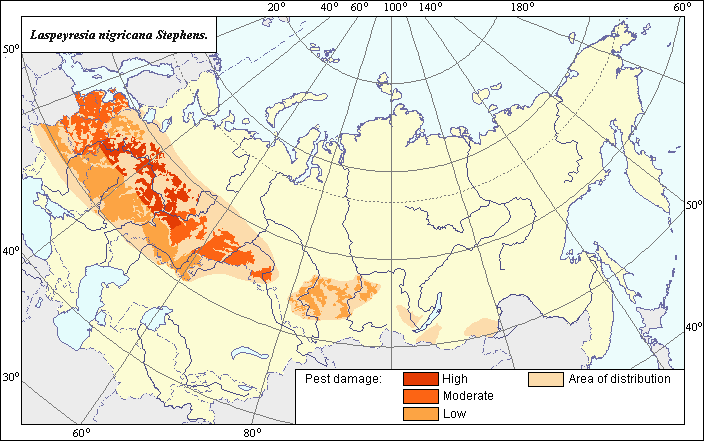Pests
Area and damage zones of Cydia nigricana Fabricius
 Object description Download GIS-layers
Object description Download GIS-layers
Authors:
Specialist-biologist M.N. Berim,GIS-specialist M.I. Saulich.
Date of creation:
27.01.2005.Scale:
1:20 000 000.Accuracy of map:
Map was created based on materials of map of natural scale 1:33 000 000.Projection:
"Alber's Equal Area Conic for the USSR", 9, 1001, 7, 100, 0, 44, 68, 0, 0.Basic contents:
Vector map. Area of species distribution is shown by polygons. Zones of recorded mass outbreak are shown by polygons.Accuracy of classifier:
The insect area is divided into zones of high, moderate and low damage based on the work of Arkhipov (1967) and other published materials listed below. The zone of high damage includes regions that are characterized by periodic damage of pea grain reaching levels above 25% (germination power decreased to 50%); the zone of moderate damage is characterized by damage of pea grain from 15 to 25% (germination power decreased to 40%); the zone of low damage is characterized by damage of pea grain at less than 15% (germination power decreased to 30%) (Lipskii, 1938).Method of map production:
Scientists were given maps with boundaries of Oblasts and arable lands. After reviewing historic literature, species distribution was hand drawn on maps. The materials of VIZR expeditions were also used. If data were on the Oblast-level, distribution is on the Oblast level. In some cases, Oblast.s are further refined by boundaries of the Arable Land Map (Koroljeva et al., 2003). Hand drawn maps were scanned, georeferenced and vectorized. The borders of the different zones harmfulness were determined based on the criteria that has been published by the following sources: Eenlaid (1953), Arkhipov (1967, 1969), Turaev et al. (1977), Volov (1979). The northern and eastern borders were determined according to the following published materials: Arkhipov (1967), Turaev et al. (1977), Volov (1979), and expedition data. The results of the analysis of host (pea) spreading, based on the atlas of the USSR vegetation, were used, taking into account the temperature preference of this insect (the insect is cold-resistant). The vector map of the distribution of peas within the territory of the Former Soviet Union was also used for the correction of damage zones (Koroleva et al., 2003).Reference citations:
Arkhipov G.E. 1967. The pea moth (Laspeyresia nigricana Steph.) and factors restricting its number and damage in Chuvash ASSR region conditions. PhD Thesis. Leningrad: VIZR. 17 p. (In Russian)Arkhipov G.E. 1969. The features of pea moth development. In: Polyakov I.M., ed. The proceedings of V scientific conference of young scientists. Leningrad: VIZR. 66-9 p. (In Russian)
Eenlaid A. 1953. The significance of pea moths Laspeyresia dorsana F. and L. nigricana Steph., that are the pea pests, their biology, ecology and possibilities of control. PhD Thesis. Tartu: Tartu University. 25 p. (In Russian)
Koroljeva IE, Vilchevskaya EV, Ruhovich DI. 2003. Digital Arable Land Map. Laboratory of Soil Information of the Dokuchaev Soil Institute, Moscow, Russia [Based on: Yanvareva LF. (ed.), Martynjuk KN., Kisileva NM. 1989. Map of Land Use, Faculty of Geography, Moscow State University, Moscow, Russia.].
Lipskii B.A. 1938. Pea moths and their control. In: Bagdanov-Kat'kov N.N., ed. The proceedings of Leningrad region plant protection station. 24 p. (In Russian)
Turaev N.S., Volov L.M. 1977. Distribution and harmfullness of pea moth in Ural. In: Turaev N.S., ed. The proceedings of Sverdlovsk Agricultural Institute. Perm': Sverdlovsk Agricultural Institute. V. 50: 38-43. (In Russian)
Turaev N.S., Volov L.M., Chislov M.E. 1977. In: Turaev N.S., ed. The proceedings of Sverdlovsk Agricultural Institute. Perm': The proceedings of Sverdlovsk Agricultural Institute. V. 50: 3-38. (In Russian)
Volov L.M. 1979. The pea moth in Middle Ural and control treatments with it. PhD Thesis. Leningrad: VIZR. 16 p. (In Russian)
Right and copyright:
All rights reserved. Copyright 2005 © M.N. Berim & M.I. Saulich (vector map, description)Photo © V.V.Neymorovets (VIZR)

